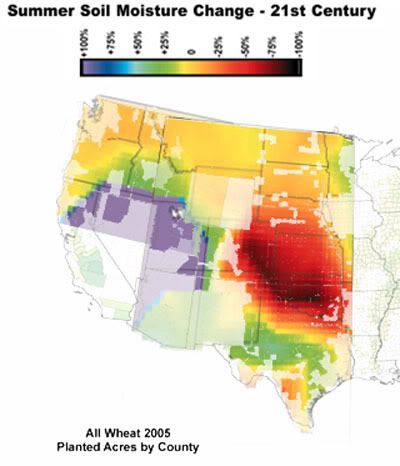The US has been known for a long time as an over-producer of wheat. Even now, the Midwest is still the breadbasket of the country, and millions of bushels of wheat are exported to other nations every year. There are 60 million acres of wheat under cultivation annually in the US. The wheat growing areas extend from Montana and North Dakota down to Oklahoma and Texas. Typically, wheat requires a temperate climate for growth. Different varieties of wheat can be grown within the temperate zone, for instance hard white wheat can be grown in a drier area, and durum wheat can be grown in colder areas such as North Dakota.
Wheat in the US is rarely irrigated, only 5% of the total wheat crop is under irrigation. Typically, wheat is planted in the fall (winter wheat), and sprouts before winter, when it is dormant. The wheat begins to grow again in the spring, and is ready for harvest in June, the exact timing depends on location and the weather. During the summer growing season, the crop is dependent on warm weather for growth, but temperatures that are too high stop growth. Harvest time is delayed by rain, and rain or hail at harvest can destroy a years worth of effort.
Over the course of the growing season, the wheat crop is subject to the vagaries of weather and natural disaster. Flooding destroyed many acres of wheat in 1999 in the US. Last year, the hot summer decimated the wheat crop in Europe.
With the falling prices of wheat, and increased demand for corn, wheat crop areas are shrinking in the US, although supply has been holding steady or declining only slightly.
While the threat of global warming harming our agriculture may seem unlikely, or something that may happen in the distant future, new research shows the West is already feeling the effects of increased warmth. This is important, given the vulnerability of the U.S. wheat crop to a hotter climate and drier soils.
I have taken a map of the prominent wheat growing areas in the U.S. published by the Department of Agriculture. On to that, I have overlayed the projected changes in soil moisture as a result of global warming in the next 50 years, published by the US EPA. As can be seen by the resulting map, the wheat growing areas are strongly impacted by the changing climate. In particular, the changes in the Great Plains climate are indicative of Dust Bowl conditions.
Interestingly, although the EPA has studied this problem, they conclude that there will only be slightly negative or somewhat positive impacts to agriculture due to global warming. This is due to the increase in growth rate with increased CO2, and "adaptation" by the farmers as a response to changing weather patterns. Wheat, however, is not very responsive to increased CO2 levels. Also, it is hard to see how farmer could respond to drought other than to stop growing wheat. There is not enough water in the underground aquifers to support irrigation for the long term.

Soil Moisture Changes to Wheat Growing Areas.
The picture may actually be bleaker than this. The current trends seem to suggest that the warmer air may not carry the increased moisture once thought. This could mean that areas in the West may suffer more, as increases in moisture where calculated to make up for soil drying.
We need to find solutions to the coming crisis that expand our adaptability. Current government policy is to ignore the potential impacts of climate change on agriculture, or minimize them. Other parts of the world may in fact be more impacted than what we see in the U.S.

No comments:
Post a Comment
Feel free to comment or send your thoughts